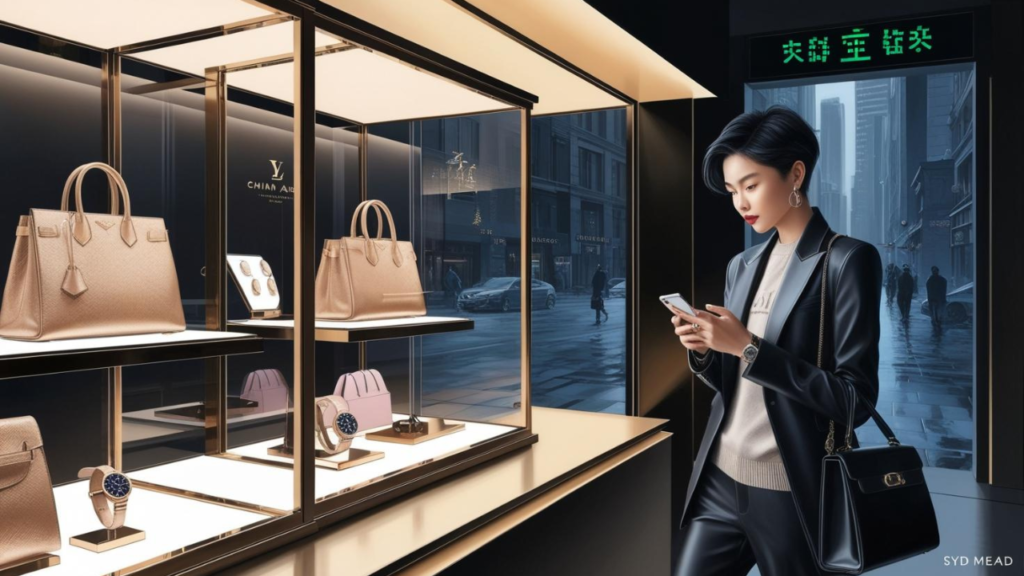As China’s economic landscape undergoes a dramatic transformation, the country’s once-thriving luxury market is facing an unexpected downturn. From shifting consumer behavior to government policies discouraging excessive wealth displays, this article explores the key reasons behind the decline and how brands are adapting

The End of China’s Luxury Boom: Economic Shifts, Consumer Trends, and Market Adaptations
For years, China has been the driving force behind the global luxury market. Major brands such as Louis Vuitton, Gucci, and Chanel saw enormous growth thanks to China’s rising middle class, eager to embrace high-end fashion. However, a combination of economic challenges, changing consumer preferences, and political shifts is now reshaping the luxury landscape. The once-booming sector is slowing down, and brands are being forced to rethink their strategies.
Economic Slowdown and the Property Market Crisis
China’s economy is facing significant headwinds. One of the biggest contributors to this slowdown is the property market crisis, which has drastically reduced household wealth. Real estate has long been a pillar of economic growth in China, with property investments forming a crucial part of personal wealth for many citizens. However, with major developers like Evergrande and Country Garden struggling with debt and defaults, property values have plummeted, leaving millions of homeowners with depreciating assets and lower disposable income.
Luxury shopping often thrives in environments where consumers feel financially secure. With uncertainty looming over the real estate market, Chinese consumers are now adopting a more cautious approach to spending, prioritizing essentials over extravagance.
Youth Unemployment and a More Frugal Generation
The economic downturn has also led to a sharp rise in youth unemployment, which reached a record high of over 20% in 2023 before the Chinese government stopped publishing the data. This demographic—once a key driver of luxury consumption—is now facing financial uncertainty, leading to a decline in discretionary spending.
Many young professionals who previously indulged in luxury goods are now opting for more affordable alternatives or delaying non-essential purchases. The frugal mindset is reshaping how brands approach marketing, as the aspirational consumer base is no longer as robust as it once was.
Changing Consumer Preferences: Experiences Over Possessions
Beyond economic struggles, a generational shift in consumer preferences is altering the luxury market landscape. Younger Chinese consumers are increasingly prioritizing experiences—such as travel, wellness, and fitness—over material possessions. Social status is now defined less by owning a luxury handbag and more by exclusive vacations, fine dining, and personal development.
This shift aligns with broader global trends, where millennials and Gen Z favor experiences over ownership. Luxury brands that traditionally relied on product sales are now expanding their offerings into hospitality, wellness, and lifestyle experiences to stay relevant.
The Rise of Dupes: Affordable Alternatives to Luxury Brands
The demand for high-quality knockoffs—also known as dupes—has surged in China. Consumers are increasingly drawn to affordable alternatives that offer a similar aesthetic without the hefty price tag. The rise of online platforms like Taobao, Xiaohongshu, and Douyin (China’s TikTok equivalent) has made it easier for consumers to discover and purchase dupes that mimic high-end brands at a fraction of the cost.
Luxury brands now face an identity crisis: how can they maintain exclusivity and desirability in a market where lookalikes are becoming more socially acceptable? Some companies are responding by doubling down on craftsmanship and unique designs, while others are investing in anti-counterfeiting measures.
Political Influence: The Impact of “Common Prosperity”
President Xi Jinping’s “common prosperity” initiative aims to reduce wealth inequality and discourage excessive displays of affluence. As a result, many wealthy Chinese individuals are being more discreet with their spending habits. Public displays of luxury are increasingly viewed as socially inappropriate, leading to a decline in flashy purchases.
Government crackdowns on corruption and tax evasion have also put luxury brands under scrutiny. Lavish spending by government officials and business executives—once a major driver of luxury sales—has diminished significantly. As a result, luxury brands are being forced to find new ways to appeal to consumers without triggering political backlash.
Luxury Brands’ Strategy Shift: Targeting the Ultra-Wealthy
In response to these challenges, luxury brands are pivoting their strategies by focusing on the ultra-wealthy elite. Instead of targeting the broader middle class, they are doubling down on their VIP clientele.
Exclusive shopping experiences, invite-only events, and bespoke product offerings are becoming the new norm. Brands like Hermès and Chanel are increasingly prioritizing top-tier customers who are less affected by economic fluctuations. Personalized services and private shopping appointments are helping maintain a sense of exclusivity, even as mass-market sales decline.
Conclusion: The New Reality for China’s Luxury Market
The golden age of China’s luxury boom appears to be over, at least in its previous form. Economic uncertainties, rising unemployment, and shifting consumer behavior are reshaping the market. While luxury brands can no longer rely on mass consumer demand, they are adapting by catering to an elite audience and exploring experiential offerings.
For brands that successfully navigate these changes, China remains a lucrative market. However, the rules of engagement have changed, and only those willing to evolve with the times will thrive in this new economic reality.


